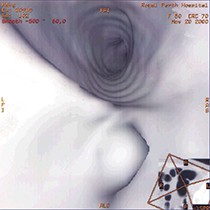Peer Reviewed
Gastroenterology clinic
An update on virtual colonoscopy (CT colonography)
Abstract
Virtual colonoscopy performed with computed tomography is a quick noninvasive technique of imaging the large bowel that should soon be more widely available in Australia.
Key Points
- Virtual colonoscopy (computed tomography colonography, or CTC) is a rapidly advancing technique that uses spiral CT to image the colon and rectum. In contrast to older generation CT scanning, which gave a series of axial slices, spiral CT obtains a ‘volume’ of information for interrogation.
- Two-dimensional cross-sectional images and computer software reconstructed three-dimensional ‘fly-through’ (virtual colonoscopy) images are obtained (Figures 1a and 1b). Image quality allows for the detection of elevated polyps, but not of finer mucosal detail such as vascular anomalies and colitis.
- Patients need to take bowel preparation as they would for conventional colonoscopy. The colon is distended with air by rectal catheter and CT imaging undertaken, during a single breath hold, in both prone and supine positions; this is to minimise false negative (that is, missed polyps) and false positive (for example, from faecaliths) findings. Sedation is not required.
- Sensitivity for detecting large polyps (1 cm and above diameter) in expert centres is similar to colonoscopy; the importance of this polyp size threshold relates to the significantly increased likelihood of current or future malignancy. Sensitivity for polyp detection decreases with decreasing polyp size.

